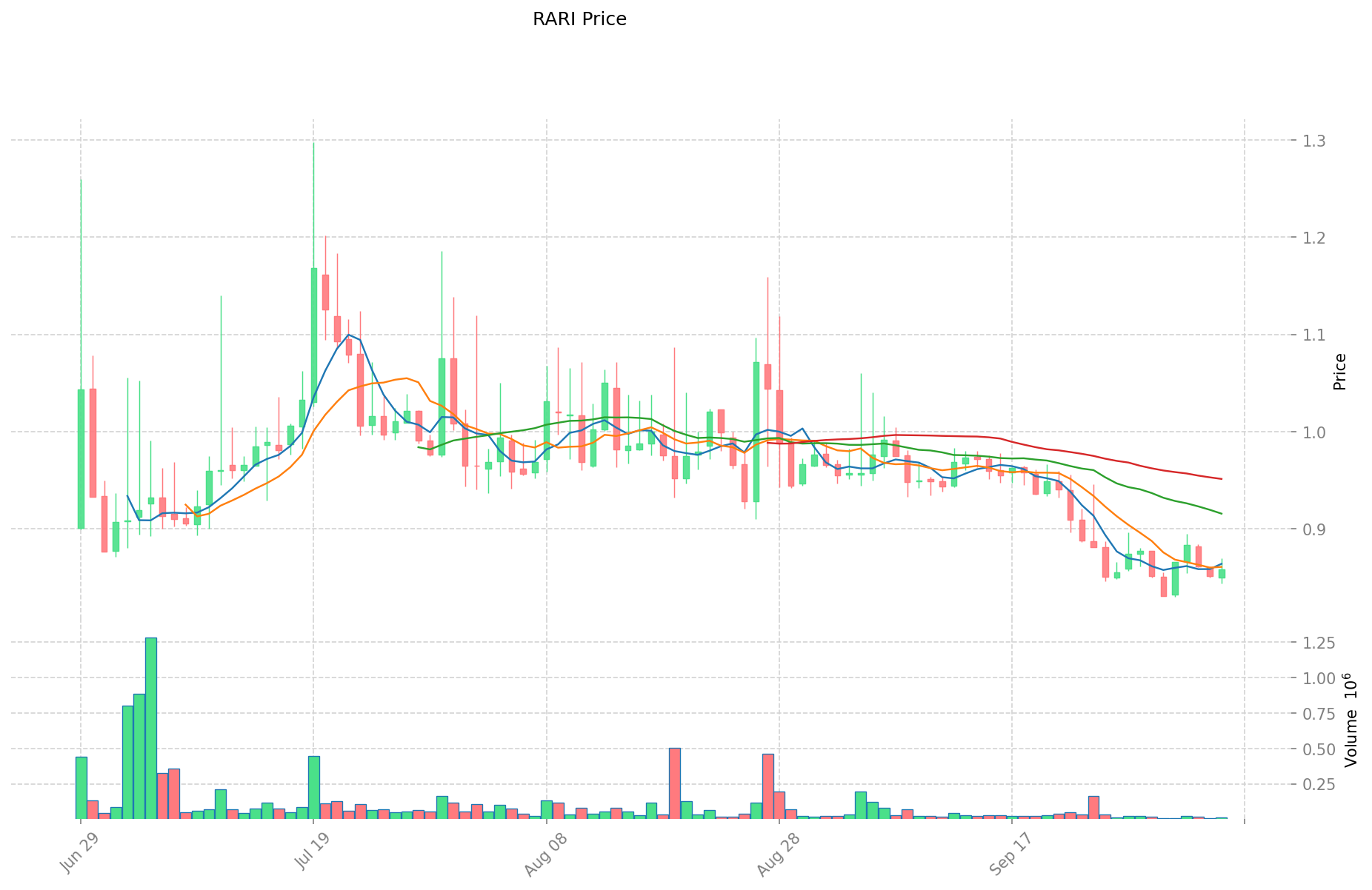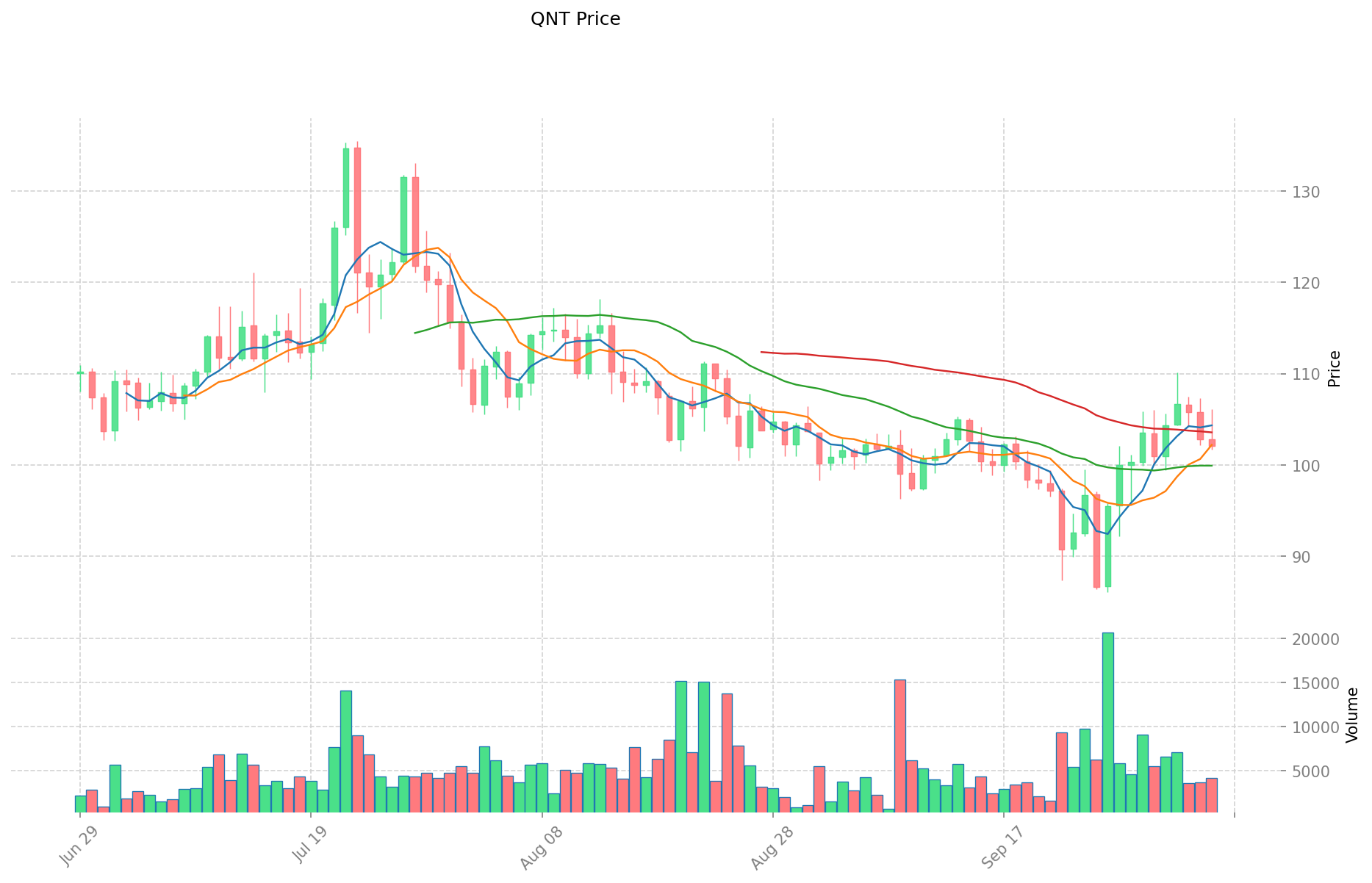RARI vs QNT: A Comparative Analysis of Two Promising Blockchain Assets
Introduction: Investment Comparison of RARI vs QNT
In the cryptocurrency market, the comparison between RARI vs QNT has always been a topic that investors cannot avoid. The two not only show significant differences in market cap ranking, application scenarios, and price performance, but also represent different positioning of crypto assets.
Rarible (RARI): Launched in 2020, it has gained market recognition for its focus on NFT infrastructure and onchain commerce.
Quant (QNT): Since its inception in 2018, it has been hailed as a solution for blockchain interoperability, becoming one of the leading platforms for enterprise innovation and blockchain adoption.
This article will comprehensively analyze the investment value comparison between RARI vs QNT, focusing on historical price trends, supply mechanisms, institutional adoption, technological ecosystems, and future predictions, attempting to answer the question that investors are most concerned about:
"Which is the better buy right now?"
I. Price History Comparison and Current Market Status
RARI and QNT Historical Price Trends
- 2021: RARI reached its all-time high of $46.7 due to the NFT market boom.
- 2021: QNT hit its all-time high of $427.42 in September, driven by increased enterprise adoption.
- Comparative Analysis: During the 2022 bear market, RARI dropped from its high to a low of $0.264878, while QNT showed more resilience, maintaining a higher price floor.
Current Market Situation (2025-10-06)
- RARI current price: $0.8609
- QNT current price: $102.29
- 24-hour trading volume: RARI $11,565.85 vs QNT $448,514.40
- Market Sentiment Index (Fear & Greed Index): 74 (Greed)
Click to view real-time prices:
- Check RARI current price Market Price
- Check QNT current price Market Price


II. Core Factors Affecting Investment Value of RARI vs QNT
Supply Mechanism Comparison (Tokenomics)
- RARI: Connected to Decentraland ecosystem with customizable features
- QNT: Part of Oracle blockchain platform, recently launched
- 📌 Historical pattern: Supply mechanisms drive price cycle variations based on blockchain platform integration.
Institutional Adoption and Market Applications
- Institutional holdings: Limited information available on institutional preference
- Enterprise adoption: QNT designed for blockchain data supply chain applications
- Regulatory attitudes: Varying regulatory frameworks depending on jurisdiction
Technical Development and Ecosystem Building
- RARI technical capabilities: Integration with Decentraland's customizable subnets
- QNT technical development: Oracle blockchain platform integration
- Ecosystem comparison: Both tokens serve specific functions within their respective blockchain ecosystems
Macroeconomic Factors and Market Cycles
- Performance during inflation: Market volatility impacts both assets similarly
- Monetary policy impact: Interest rates and USD index affect crypto market broadly
- Geopolitical factors: Cross-border transaction demands influence adoption rates
III. 2025-2030 Price Prediction: RARI vs QNT
Short-term Prediction (2025)
- RARI: Conservative $0.61 - $0.86 | Optimistic $0.86 - $1.19
- QNT: Conservative $69.51 - $102.22 | Optimistic $102.22 - $146.17
Mid-term Prediction (2027)
- RARI may enter a growth phase, with prices expected in the range of $1.20 - $1.73
- QNT may enter a consolidation phase, with prices expected in the range of $73.95 - $166.38
- Key drivers: Institutional capital inflow, ETF, ecosystem development
Long-term Prediction (2030)
- RARI: Base scenario $0.97 - $1.90 | Optimistic scenario $1.90 - $2.15
- QNT: Base scenario $96.56 - $185.68 | Optimistic scenario $185.68 - $200.54
Disclaimer: The information provided is for informational purposes only and should not be considered as financial advice. Cryptocurrency markets are highly volatile and unpredictable. Always conduct your own research before making any investment decisions.
RARI:
| 年份 | 预测最高价 | 预测平均价格 | 预测最低价 | 涨跌幅 |
|---|---|---|---|---|
| 2025 | 1.188042 | 0.8609 | 0.611239 | 0 |
| 2026 | 1.44450411 | 1.024471 | 0.95275803 | 19 |
| 2027 | 1.728282577 | 1.234487555 | 1.19745292835 | 43 |
| 2028 | 2.0739390924 | 1.481385066 | 1.28880500742 | 72 |
| 2029 | 2.026534770288 | 1.7776620792 | 0.906607660392 | 106 |
| 2030 | 2.14937121996072 | 1.902098424744 | 0.97007019661944 | 120 |
QNT:
| 年份 | 预测最高价 | 预测平均价格 | 预测最低价 | 涨跌幅 |
|---|---|---|---|---|
| 2025 | 146.1746 | 102.22 | 69.5096 | 0 |
| 2026 | 160.214517 | 124.1973 | 93.147975 | 21 |
| 2027 | 166.380912945 | 142.2059085 | 73.94707242 | 39 |
| 2028 | 174.351554116425 | 154.2934107225 | 108.00538750575 | 50 |
| 2029 | 207.04632784852275 | 164.3224824194625 | 123.241861814596875 | 60 |
| 2030 | 200.539157544712035 | 185.684405133992625 | 96.555890669676165 | 81 |
IV. Investment Strategy Comparison: RARI vs QNT
Long-term vs Short-term Investment Strategy
- RARI: Suitable for investors focused on NFT infrastructure and onchain commerce potential
- QNT: Suitable for investors interested in enterprise blockchain adoption and interoperability solutions
Risk Management and Asset Allocation
- Conservative investors: RARI: 30% vs QNT: 70%
- Aggressive investors: RARI: 60% vs QNT: 40%
- Hedging tools: Stablecoin allocation, options, cross-currency portfolios
V. Potential Risk Comparison
Market Risk
- RARI: Highly dependent on NFT market trends and overall crypto market sentiment
- QNT: Susceptible to fluctuations in enterprise blockchain adoption rates
Technical Risk
- RARI: Scalability, network stability
- QNT: Interoperability challenges, potential security vulnerabilities
Regulatory Risk
- Global regulatory policies may have differing impacts on both assets, with NFT-focused RARI potentially facing more scrutiny in some jurisdictions
VI. Conclusion: Which Is the Better Buy?
📌 Investment Value Summary:
- RARI advantages: Strong position in the NFT infrastructure space, potential for growth in onchain commerce
- QNT advantages: Established enterprise adoption, focus on blockchain interoperability solutions
✅ Investment Advice:
- New investors: Consider a balanced approach, leaning towards QNT for its more established market position
- Experienced investors: Explore a strategic mix of both assets, adjusting based on risk tolerance and market trends
- Institutional investors: Focus on QNT for its enterprise-grade solutions, while keeping an eye on RARI's potential in the evolving NFT space
⚠️ Risk Warning: The cryptocurrency market is highly volatile, and this article does not constitute investment advice. None
VII. FAQ
Q1: What are the main differences between RARI and QNT? A: RARI focuses on NFT infrastructure and onchain commerce, while QNT specializes in blockchain interoperability and enterprise solutions. RARI is more closely tied to the NFT market trends, whereas QNT is geared towards enterprise adoption of blockchain technology.
Q2: Which token has shown better price stability historically? A: Based on historical data, QNT has demonstrated more price resilience, maintaining a higher price floor during market downturns compared to RARI.
Q3: How do the current market prices of RARI and QNT compare? A: As of 2025-10-06, RARI's price is $0.8609, while QNT's price is $102.29. QNT has a significantly higher market price and trading volume compared to RARI.
Q4: What are the key factors affecting the investment value of these tokens? A: Key factors include supply mechanisms, institutional adoption, technical development, ecosystem building, and macroeconomic factors such as inflation and monetary policy.
Q5: What are the long-term price predictions for RARI and QNT? A: By 2030, RARI is predicted to range from $0.97 to $2.15, while QNT is expected to range from $96.56 to $200.54 in optimistic scenarios. However, these predictions are subject to market volatility and should not be considered financial advice.
Q6: How should investors allocate their assets between RARI and QNT? A: Conservative investors might consider allocating 30% to RARI and 70% to QNT, while aggressive investors might opt for 60% RARI and 40% QNT. The exact allocation should be based on individual risk tolerance and market analysis.
Q7: What are the primary risks associated with investing in RARI and QNT? A: Both tokens face market risks tied to overall crypto sentiment. RARI is particularly vulnerable to NFT market trends, while QNT's risks are more related to enterprise blockchain adoption rates. Both also face technical and regulatory risks, with RARI potentially facing more scrutiny in some jurisdictions due to its NFT focus.
Share
Content